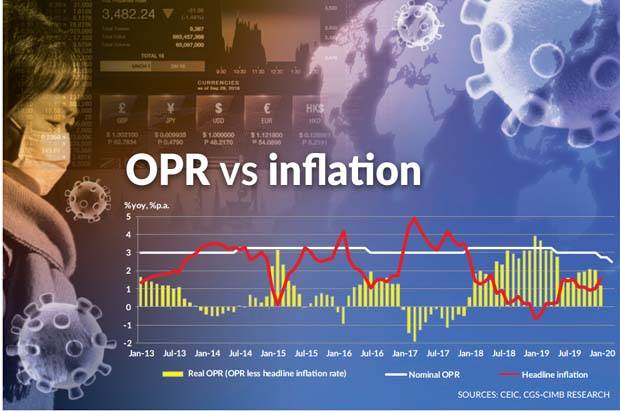Malaysia: Gradual pickup seen in economy in second half
PETALING JAYA: The overnight policy rate (OPR) cut, coupled with the economic stimulus package, should buffer the impact of Covid-19 outbreak on the economy.
The domestic economy is slated for a gradual pickup in the second half of the year, in line with the stimulus package and OPR rate cut gradually taking effect.
However, this is premised on Covid-19 subsiding and economic activity normalising in the second half of the year, as well as the speed at which the government is able to deploy the stimulus package measures.
CGS-CIMB opined that further cuts will only occur should the economy fail to recover in the latter half of the year.
“Bank Negara will adopt a wait-and-see approach at the next Monetary Policy Committee meeting as it digests the impact of Covid-19, the implementation of the RM20bil economic stimulus package and recent changes in domestic politics, on the economy.
“We share the central bank’s prognosis of a gradual recovery in the second half of 2020, as the outbreak subsides and economic activity normalises, which in our view may not necessitate further policy support.
“We retain our year-end OPR forecast of 2.5%, implying no further policy rate changes this year, ” said CGS-CIMB in its economics note yesterday.
On the contrary, Fitch Solutions expects three additional 25 basis points cuts to the OPR in 2020, bringing its rate forecast to 1.75%.
This is in line with Fitch Solutions’ lower economic forecast of 3.7% real gross domestic product (GDP) growth in 2020, which was revised from 4.5% in light of Covid-19.
“The main motivating factor behind Bank Negara’s easing would be to support a weak economy, which faces increasing downside risks from a global outbreak of Covid-19.
“In addition, the central bank will likely also have to step up monetary stimulus in the face of political uncertainty sparked by the collapse of the Pakatan Harapan government, and the likely limitations that will impose on policy making and fiscal stimulus, ” it said.
On Tuesday, Bank Negara reduced the OPR rate to 2.5% from the previous 2.75%, with the intention to provide a more accommodative monetary environment to support the projected improvement in economic growth amid price stability.
AmBank Research expects another 25 basis points rate cut, in the event of a need to support private expenditure and ease upwards pressure on non-performing loans.
The research house said that the freeing up of 50 basis points will generate around RM8bil to RM9bil which can be injected into the Special Investment fund to aid small and medium enterprises (SMEs).
“Room for lowering the Statutory Reserve Requirement (SRR) ratio by 50 to 100 basis points remains.
“With the OPR cut, it may provide some short-term positive impetus for the ringgit, more likely to appreciate against the US dollar around 0.1% to 0.2%. “However, any movement in the ringgit will be influenced by ongoing external and domestic challenges.
“The rate cut should see bond yields in the near term probably falling around 1.5% to 2%, ” said AmBank Research.
CGS-CIMB highlighted that the government’s projections of GDP growth in 2020 were recently downgraded to 3.2% to 4.2%, marked by weakness in export-oriented sectors and household spending.
Furthermore, regional disruptions to travel and production have led to greater risk aversion, resulting in tighter financial conditions and greater financial market volatility.
According to CGS-CIMB, OPR cuts are positive for cyclical sectors such as property, automotive, and consumer due to the increase in consumers’ disposable incomes.
“However, we do not expect the impact to be significant.
“A rate cut is also positive for companies with high ringgit borrowings as it will result in lower interest expenses, ” the research house said.
On the other hand, an OPR cut is negative for banks, as the downward repricing of lending rates is historically wider than the decrease in deposit rates, which causes a potential narrowing in banks’ net interest margins. The OPR cut is also negative for companies with high net cash balances as it will result in lower interest income.
While a rate cut can help businesses reduce their borrowing costs, CGS-CIMB opined that the move may not be sufficient to boost the performance of the FBM KLCI as the banks’ earnings may be negatively affected.
The KLCI fell in the three months following four of the past six rate cuts.
“Overall, we are of the view that the rate cut is likely to be negative for overall KLCI earnings, as the impact from the net interest margin squeeze on banks would likely overshadow potential interest savings for KLCI constituent companies.
“We roughly estimate that a 25 basis points cut in OPR rate could lower borrowing costs and lift our 2020 KLCI earnings estimate by 0.5% and KLCI by 8 points.
“We are keeping our KLCI target of 1,497 points, ” said CGS-CIMB.
As for inflation, the research house expects core inflation to be more moderate, as an uncertain external and domestic environment in the first half of the year weighs on labour market conditions and demand-driven price pressures.
Source: https://www.thestar.com.my/business/business-news/2020/03/05/gradual-pickup-seen-in-economy-in-second-half


 Thailand
Thailand




